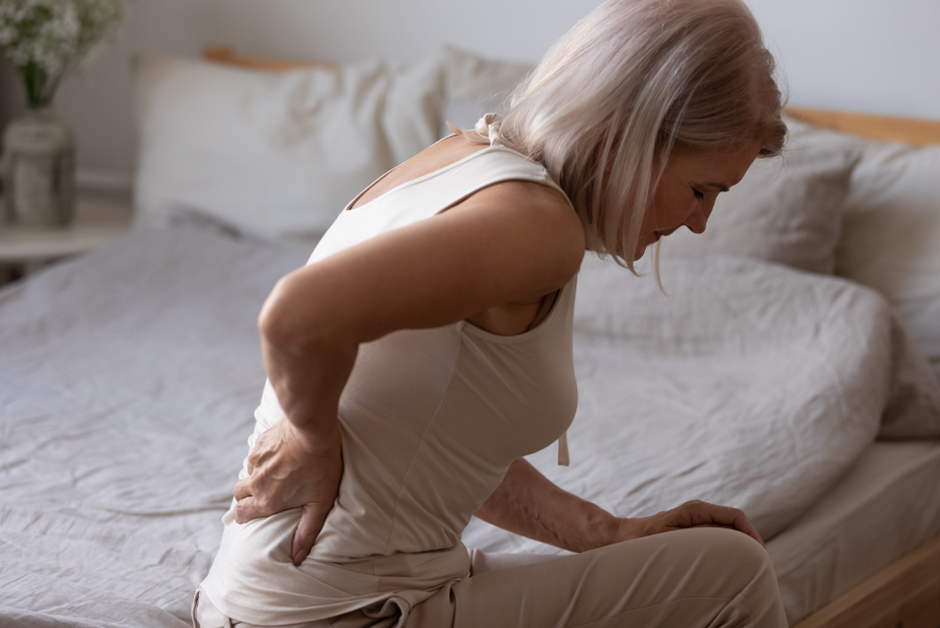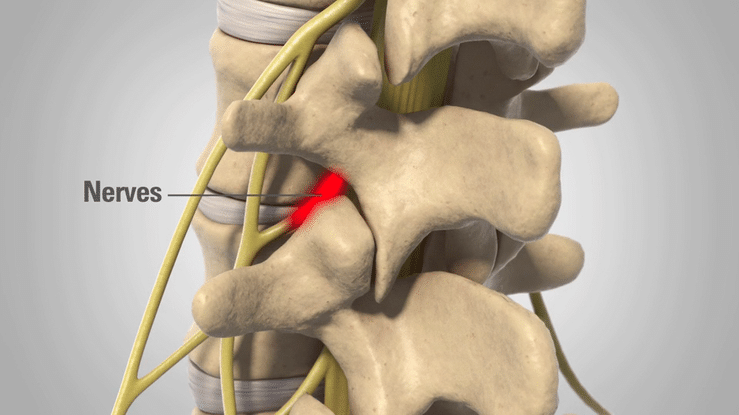About Lumbar Spinal Stenosis
Stenotic lumbar vertebrae compress the spinal cord and nerve roots traveling through them. In the lumbar region, this translates to a progressive loss of function of the lower extremities, as well as potentially affecting other bodily functions such as urination. The cause of compression can vary, but is often a result of bulges in the intervertebral discs cushioning the connections of the vertebral column. These bulging discs compress nearby structures, and damaged tissues will release inflammatory mediators in an attempt to recruit healing factors. Unfortunately, these mediators lead to inflammation and further compression, which can lead to permanent damage to the nerves if left untreated.
The cause of compression can vary, but is often a result of bulges in the intervertebral discs cushioning the connections of the vertebral column. These bulging discs compress nearby structures, and damaged tissues will release inflammatory mediators in an attempt to recruit healing factors. Unfortunately, these mediators lead to inflammation and further compression, which can lead to permanent damage to the nerves if left untreated.
About Lumbar Spinal Stenosis
Stenotic lumbar vertebrae compress the spinal cord and nerve roots traveling through them. In the lumbar region, this translates to a progressive loss of function of the lower extremities, as well as potentially affecting other bodily functions such as urination. The cause of compression can vary, but is often a result of bulges in the intervertebral discs cushioning the connections of the vertebral column. These bulging discs compress nearby structures, and damaged tissues will release inflammatory mediators in an attempt to recruit healing factors. Unfortunately, these mediators lead to inflammation and further compression, which can lead to permanent damage to the nerves if left untreated.
The cause of compression can vary, but is often a result of bulges in the intervertebral discs cushioning the connections of the vertebral column. These bulging discs compress nearby structures, and damaged tissues will release inflammatory mediators in an attempt to recruit healing factors. Unfortunately, these mediators lead to inflammation and further compression, which can lead to permanent damage to the nerves if left untreated.
DECREASED ENDURANCE DURING PHYSICAL EXERCISE AND ACTIVITIES
WEAKNESS AND/OR LOSS OF BALANCE
NUMBNESS OR A “PRICKLY” FEELING IN YOUR LEGS, CALVES, OR BUTTOCKS
SYMPTOMS IMPROVE WHEN YOU SIT, LEAN FORWARD, LIE ON YOUR BACK, OR SIT WITH YOUR FEET RAISED
ACHING, DULL BACK PAIN RADIATING (SPREADING) TO YOUR LEGS
NEUROGENIC CLAUDICATION

Can Lumbar Spinal Stenosis be dangerous?
In most cases, there is little serious risk involved in lumbar stenosis, but long-standing and untreated conditions may progress to permanent disability. If only the lower extremities are involved, then cause for less concern. If bowel or bladder problems occur, however, prompt medical evaluation is highly recommended.

Can Lumbar Spinal Stenosis be dangerous?
In most cases, there is little serious risk involved in lumbar stenosis, but long-standing and untreated conditions may progress to permanent disability. If only the lower extremities are involved, then cause for less concern. If bowel or bladder problems occur, however, prompt medical evaluation is highly recommended.
How is Lumbar Spinal Stenosis managed?
In the management of lumbar spinal stenosis, both surgical and non-surgical options exist, and generally the non-surgical ones will be exhausted prior to surgery. Over the counter medications for pain and inflammation, as well as physical therapy and spinal injections can all serve to reduce pain and progression of the disease. In patients for whom this treatment is inadequate, surgery may be recommended. The goal of surgery is primarily to reduce pain in the legs and resolve bowel or bladder problems, and is less reliable for reducing pain in the back. Most patients are able to resume all normal activities in six to nine months after surgery.


How is Lumbar Spinal Stenosis managed?
In the management of lumbar spinal stenosis, both surgical and non-surgical options exist, and generally the non-surgical ones will be exhausted prior to surgery. Over the counter medications for pain and inflammation, as well as physical therapy and spinal injections can all serve to reduce pain and progression of the disease. In patients for whom this treatment is inadequate, surgery may be recommended. The goal of surgery is primarily to reduce pain in the legs and resolve bowel or bladder problems, and is less reliable for reducing pain in the back. Most patients are able to resume all normal activities in six to nine months after surgery.
![dr ronjon paul md (1020x681px) - how is [condition] diagnosed? https://paulspine.com/wp-content/uploads/2021/01/dr-ronjon-paul-md-1020x681px-how-is-condition-diagnosed.jpg](https://paulspine.com/wp-content/uploads/2021/01/Dr-Ronjon-Paul-MD-1020x681px-How-is-condition-diagnosed.jpg)
How is Lumbar Spinal Stenosis diagnosed?
Physical examination and patient history will be performed, along with possible neurologic evaluation for nerve function in the lower extremities. X-rays, MRI, and contrast CT are all excellent options for visualizing the structures of the back in greater detail to assess the problematic areas, and may be ordered in the course of diagnosis.
![dr ronjon paul md (1020x681px) - how is [condition] diagnosed? https://paulspine.com/wp-content/uploads/2021/01/dr-ronjon-paul-md-1020x681px-how-is-condition-diagnosed.jpg](https://paulspine.com/wp-content/uploads/2021/01/Dr-Ronjon-Paul-MD-1020x681px-How-is-condition-diagnosed.jpg)
How is Lumbar Spinal Stenosis diagnosed?
Physical examination and patient history will be performed, along with possible neurologic evaluation for nerve function in the lower extremities. X-rays, MRI, and contrast CT are all excellent options for visualizing the structures of the back in greater detail to assess the problematic areas, and may be ordered in the course of diagnosis.








